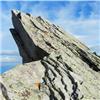Couldn’t find this topic in my searches, so hoping you all can point me in the right direction:
Where can we find a list of water sources in and around Colorado mountains and trails that are unsafe to drink due to issues such as mining activity, agriculture, livestock, etc?
I ask because it was mentioned in passing that a creek by Uncompaghre (Nellie?) was unsafe to drink due to past mining activity, which made me wonder where else should I plan to pack in my drinking water?
Going a step further, are there details of the risks that would help us make informed decisions? For example, maybe the lead content in a creek is above recommended levels, but low enough that someone may choose to consider it for back up use on a day trip?
Thank you!
Impacted Water Sources
Forum rules
- This is a mountaineering forum, so please keep your posts on-topic. Posts do not all have to be related to the 14ers but should at least be mountaineering-related.
- Personal attacks and confrontational behavior will result in removal from the forum at the discretion of the administrators.
- Do not use this forum to advertise, sell photos or other products or promote a commercial website.
- Posts will be removed at the discretion of the site administrator or moderator(s), including: Troll posts, posts pushing political views or religious beliefs, and posts with the purpose of instigating conflict within the forum.
-
mtn14

- Posts: 10
- Joined: 9/5/2022
- 14ers: 42 1
- 13ers: 3
- Trip Reports (0)
Re: Impacted Water Sources
I second this question. I’ve read that few water sources in the San Juan’s are safe, but have filtered a whole lot personally out there. Perhaps the cancer causing chemicals from being a mechanic is keeping me safe.
-
randalmartin

- Posts: 1533
- Joined: 5/4/2008
- 14ers: 58 1
- 13ers: 59 2
- Trip Reports (13)
Re: Impacted Water Sources
Mining impacted streams are usually pretty easy to spot (like the one from Uncompahgre) where you can see in the color/milky water and the fact that minerals have grown on the rocks in the stream from the heavy mineralization to the water from mining. Chicago Basin is another I have seen with similar characteristics. In those cases I try to get water from higher sources that are not impacted such as feeder streams or higher alpine lakes that don't appear to have the mineral content.
For agriculture/livestock impact, your filter/water treatment should take care of that. Of course, I wouldn't be getting water from a stagnant pond that cattle have clearly been around just because even after treatment the water will probably still taste bad.
For agriculture/livestock impact, your filter/water treatment should take care of that. Of course, I wouldn't be getting water from a stagnant pond that cattle have clearly been around just because even after treatment the water will probably still taste bad.
-
Monte Meals

- Posts: 510
- Joined: 5/16/2011
- Trip Reports (0)
Re: Impacted Water Sources
"According to a 2017 study, there are over 23,000 abandoned mines across Colorado and
1,800 miles of streams that are impaired due to pollutants related to acid mine drainage."
https://waterdesk.org/2019/09/acid-mine-drainage/
1,800 miles of streams that are impaired due to pollutants related to acid mine drainage."
https://waterdesk.org/2019/09/acid-mine-drainage/
-
jibler

- Posts: 748
- Joined: 6/12/2008
- 14ers: 13
- 13ers: 41
- Trip Reports (19)
Re: Impacted Water Sources
yes i too second that emotion for better stream info.
I sometimes wonder....
I sometimes wonder....
Keep looking up - Jack Horkheimer
-
HikerGuy

- Posts: 1463
- Joined: 5/25/2006
- 14ers: 58
- 13ers: 508 8
- Trip Reports (9)
Re: Impacted Water Sources
Here you go, this page contains the links below and has the info you are looking for in regard to mines. The interactive map is probably most useful.
https://cdphe.colorado.gov/mine-impacte ... task-force
Abandoned mines water quality study
This study is a collaborative effort focused on water discharged from 145 abandoned mines that could impact Colorado lakes and streams.
Interactive map - Colorado Abandoned Mine Land Water Quality Information.
Fact sheet - Overview.
Report - Abandoned Mines Water Quality Study.
Note, that is for mine-impacted water sources. There are also water sources impacted by naturally-occurring geological processes. I used to have a map of those, but can't find it right now.
EDIT: found it. Free download here: https://coloradogeologicalsurvey.org/pu ... -colorado/
https://cdphe.colorado.gov/mine-impacte ... task-force
Abandoned mines water quality study
This study is a collaborative effort focused on water discharged from 145 abandoned mines that could impact Colorado lakes and streams.
Interactive map - Colorado Abandoned Mine Land Water Quality Information.
Fact sheet - Overview.
Report - Abandoned Mines Water Quality Study.
Note, that is for mine-impacted water sources. There are also water sources impacted by naturally-occurring geological processes. I used to have a map of those, but can't find it right now.
EDIT: found it. Free download here: https://coloradogeologicalsurvey.org/pu ... -colorado/
Re: Impacted Water Sources
If the water has stained the rocks a rusty red, its mine runoff.
If the water is whitish/light bluish and has bleached the rocks, its also mine runoff.
Of course, drinking a liter or two of it won't kill you or make you sick, but its not good long term.
If the water is whitish/light bluish and has bleached the rocks, its also mine runoff.
Of course, drinking a liter or two of it won't kill you or make you sick, but its not good long term.
After climbing a great hill, one only finds that there are many more hills to climb. -Nelson Mandela
Whenever I climb I am followed by a dog called Ego. -Nietzsche
Whenever I climb I am followed by a dog called Ego. -Nietzsche
-
Marmot72

- Posts: 434
- Joined: 9/2/2007
- 14ers: 58 2
- 13ers: 626 17
- Trip Reports (43)
Re: Impacted Water Sources
Weird yellow color on the rocks is another sign of contamination from mines. The map is extremely helpful though because, for instance, upper Matterhorn Creek looks fine to the eye, but it’s also contaminated. Of course I drink a liter of that water in 2005 unaware of that circumstance, and I don’t think it’s done me any worse than the innumerable beers I’ve consumed since that time.
I have phenomenal route-finding abilities. Specifically, I have an uncanny knack for selecting the path of most resistance.
-
Scott P

- Posts: 9598
- Joined: 5/4/2005
- 14ers: 58 16
- 13ers: 50 13
- Trip Reports (16)
Re: Impacted Water Sources
Sometimes you can't see the contamination. I've been to a lot of water sources said to be contaminated with arsenic or uranium and all of them were clear.
I'm old, slow and fat. Unfortunately, those are my good qualities.
-
justiner

- Posts: 4690
- Joined: 8/28/2010
- 14ers: 3 1
- Trip Reports (37)
Re: Impacted Water Sources
I think this is a really interesting topic. I wish there was (a a testing kit someone like me could take to an area and (b the time to do an informal survey. You could take a sampling of a section of the Colorado Trail, for example while backpacking it. And then have others do the same test to collect more data points. That information could actually be useful, as water sources along the way are already documented in various guides. Should they all be used/trusted or are there ones that are best skipped?
My guess though is that water quality cared most about by hikers/backpackers is impacted mostly by human/livestock/wildlife waste. Thankfully, there are water purification protocols that work.
Heavy metals are a whole different problem, and there just aren't really easy protocols to remove them (though I do have some commercially available options I've never tried). I would wager to guess that many (not all) are easily identifiable by creek health as described above, but Scott makes some good points about problems like uranium mine pollution impacting water source, which is a huge, huge, huge problem on reservations near where uranium mining once was done.
Although the plutonium contamination issue east/downwind of Rocky Flats a stone's throw from me should really be addressed more openly...
My guess though is that water quality cared most about by hikers/backpackers is impacted mostly by human/livestock/wildlife waste. Thankfully, there are water purification protocols that work.
Heavy metals are a whole different problem, and there just aren't really easy protocols to remove them (though I do have some commercially available options I've never tried). I would wager to guess that many (not all) are easily identifiable by creek health as described above, but Scott makes some good points about problems like uranium mine pollution impacting water source, which is a huge, huge, huge problem on reservations near where uranium mining once was done.
Although the plutonium contamination issue east/downwind of Rocky Flats a stone's throw from me should really be addressed more openly...
Long May You Range! Purveyors of fine bespoke adventures
Re: Impacted Water Sources
If I'm not sure, I'll turn over some rocks and look for microorganisms. Far from foolproof, but if heavy metal pollution is that high nothing will be living in there. I just finished the CT - I only skipped over two creeks that had stained the rocks clearly indicating mining waste. But skipped over many shallow streams with feces afoot.
Traveling light is the only way to fly.
IG: @colorado_invasive
Strava: Brent Herring
IG: @colorado_invasive
Strava: Brent Herring
-
Monte Meals

- Posts: 510
- Joined: 5/16/2011
- Trip Reports (0)
Re: Impacted Water Sources
^ "Of course, drinking a liter or two of it won't kill you or make you sick, but its not good long term."
Also consider not eating any fish from the streams.
They tend to concentrate any heavy metals.
A liter of water may be one thing
But a 6 oz fish filet may be quite dangerous.
Also consider not eating any fish from the streams.
They tend to concentrate any heavy metals.
A liter of water may be one thing
But a 6 oz fish filet may be quite dangerous.


